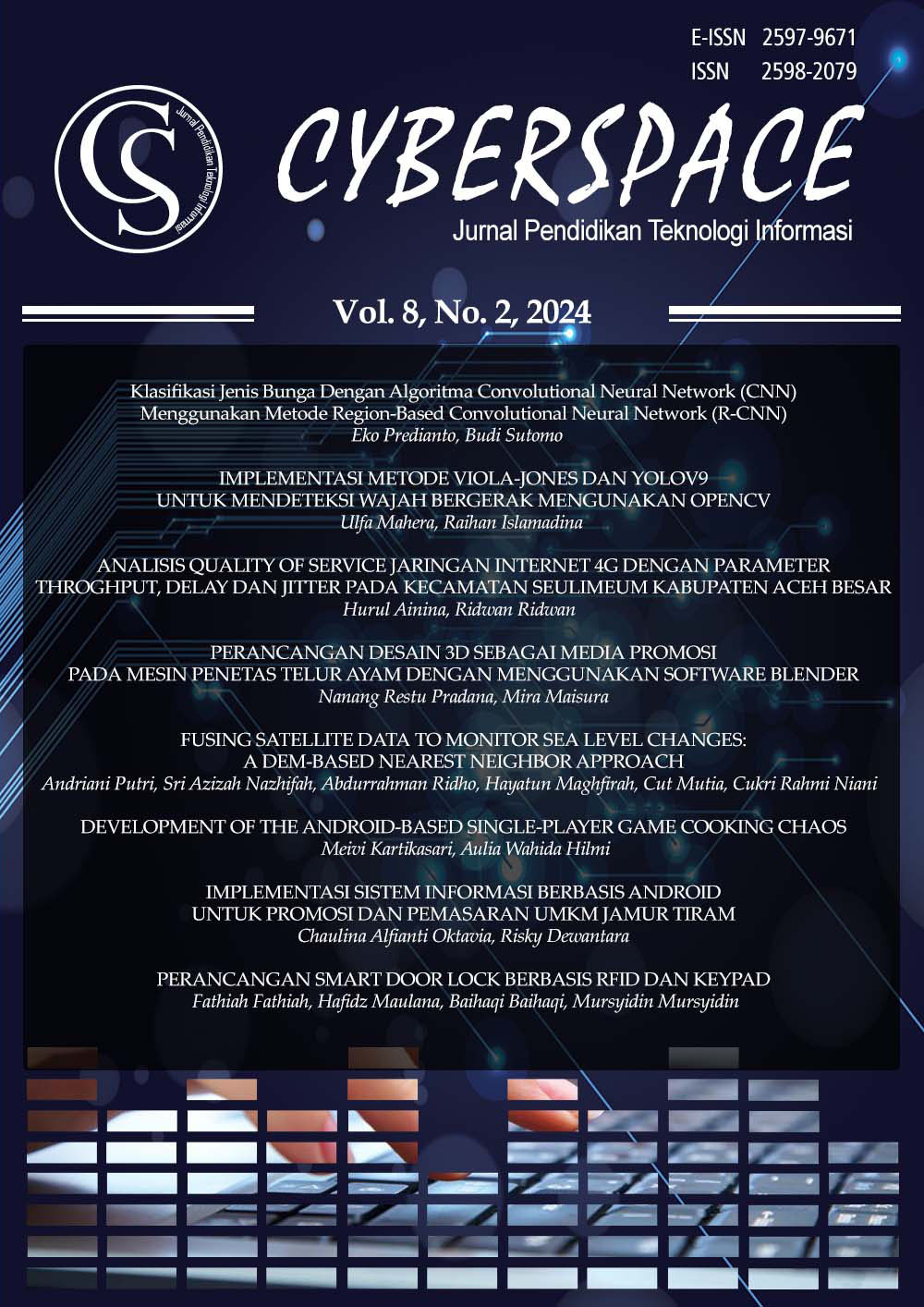PERANCANGAN SMART DOOR LOCK BERBASIS RFID DAN KEYPAD
DOI:
https://doi.org/10.22373/cj.v8i2.25668Keywords:
Door security, RFID, Keypad, Access Control SystemAbstract
Security and security are important issues in everyday life. Using simple authentication systems such as mechanical keys has proven vulnerable to breaches. RFID technology and keypads are considerable solutions to this problem. The research aims to design and implement a smart door locking system that combines RFID and keypad technology to enhance room security. System design is based on ease of use, reliability, and security. The system is designed with a higher level of security, i.e. by combining RFID, keypad, and PIR sensors so that to open the door it requires an RFID scan, inserting a pin on the keypad and moving hands or something else to detect movement by the PIR sensor. The evaluation of usability shows that the system is well accepted by users with an average of 4.2 on the 5th scale.References
M. T. Sholehati And A. Goeritno, “Sistem Minimum Berbasis Mikrokontroler Atmega2560 Sebagai Sistem Pengaman Pada Analogi Lemari Penyimpanan Brankas,” Syiah Kuala Univ., Vol. 14, No. 3, 2018, Doi: 10.17529/Jre.V14i3.11649.
S. Faradita And R. Candra, “Pengisi Username Dan Password Otomatis Dengan Sistem Keamanan Menggunakan RFID,” Vol. 18, No. 4, 2019, Doi: 10.32409/Jikstik.18.4.2658.
E. Elisa, N. Azwanti, And P. Simanjuntak, “Perancangan Sistem Informasi Jasa Bantu Pindah Berbasis Web,” Pros. Semin. Nas. Ilmu Sos. Dan Teknol., Vol. 3, No. September, Pp. 49–54, 2020, [Online]. Available: Https://Ejournal.Upbatam.Ac.Id/Index.Php/Prosiding/Article/View/3612
A. Salam And S. B. Bhaskoro, “Sistem Keamanan Cerdas Pada Kunci Pintu Otomatis Menggunakan Kode QR,” Cybernetics, Vol. 5, No. 01, Pp. 1–11, 2021, Doi: 10.29406/Cbn.V5i01.2307.
R. Mu’arif Et Al., “Perancangan Sistem Akses Pintu Otomatis Menggunakan RFID Card,” Juktisi, Vol. 1, No. 3, Pp. 170–178, 2023.
R. Gustari And D. D. S. Fatimah, “Perancangan Sistem Pembaca Kartu Mahasiswa Berbasis Radio Frequency Identification,” Vol. 14, No. 2, Pp. 420–427, 2014, Doi: 10.33364/Algoritma/V.14-2.420.
A. Basit, A. Sya’bani Putra, G. Ayu Revira, And R. Nur Widia, “Smart Door Lock Berbasis QR Code,” Smart Comp Jurnalnya Orang Pint. Komput., Vol. 11, No. 1, Pp. 5–8, 2022, Doi: 10.30591/Smartcomp.V11i1.3179.
W. K. Raharja And B. Santoso, “PURWARUPA ALAT TELEMONITORING KEAMANAN RUANGAN MENGGUNAKAN IDENTIFIKASI SIDIK JARI BERBASIS INTERNET OF THINGS,” Vol. 6, No. 2, Pp. 156–168, 2020, Doi: 10.32531/Jelekn.V6i2.227.
D. N. Ilham, R. A. Candra, A. Budiansyah, E. Sipahutar, M. K. Harahap, And F. Anugreni, “Implementation Of Vibration Sensor And Pin Lock Using Keypad For Charity Box Security,” Int. J. Multidiscip. Sci. Arts, Vol. 1, No. 2, Pp. 125–133, Jan. 2022, Doi: 10.47709/IJMDSA.V1I2.2050.
R. Toyib And J. Hidayatullah, “APLIKASI REMOTE KONTROL CPU/LAPTOP JARAK JAUH DENGAN MEDIA SERIAL HANDPHONE DENGAN MIKROKONTROLER,” Vol. 3, No. 1, Pp. 50–60, 2016, Doi: 10.33369/Pseudocode.3.1.50-60.
R. Suwartika And G. Sembada, “Perancangan Sistem Keamanan
Menggunakan Solenoid Door Lock Berbasis Arduino Uno Pada Pintu Laboratorium Di PT. XYZ,” J. E-Komtek, Vol. 4, No. 1, Pp. 62–74, 2020, Doi: 10.37339/E-Komtek.V4i1.217.
A. Gistya Sudiartama, D. Darlis, And A. Hartaman, “Design And Realization Of Smart Plug Based On QR Code And WIFI Access,” Vol. 1, No. 2, Pp. 92–100, 2023, [Online]. Available: Https://Creativecommons.Org/Licenses/By/4.0/
Suci Br Kembaren, Elsadora Haroannauli Patricia Br Gurning, And Any Kurniawaty Yapie, “IOT Pada Purwarupa Sistem Keamanan Pintu Kantor Dengan Sensor RFID Dan PIR Berbasis Telegram,” J. Tek. Mesin, Elektro Dan Ilmu Komput., Vol. 3, No. 3, Pp. 84–97, 2023, Doi: 10.55606/Teknik.V3i3.2510.
B. A. Prasetya, “Rancang Bangun Prototype Kendali Pintu Kantor Berbasis Rfid Dan Iot,” Tugas Akhir Thesis, Univ. Technol. Yogyakarta, Pp. 1–10, 2019.
R. Mardikaningsih And D. Darmawan, “Peranan Sistem Informasi Persediaan Terhadap Persepsi Kemudahan Penggunaan, Kegunaan Yang Dirasakan, Dan Kepuasan Pengunjung Toko Buku,” Realible Account. J., Vol. 1, No. 1, Pp. 43–57, 2021, Doi: 10.36352/Raj.V1i1.135.
C. R. Mabruri, “Evaluasi Layanan Pengaduan Online Ombudsman Republik Indonesia Dengan Usability Evaluation Methods,” Progr. Stud. Sist. Inf. Fak. Sains Dan Teknol. Univ. Islam Negeri Syarif Hidayatullah Jakarta, 2019.
Wiwesa N, “User Interface Dan User Experience Untuk Mengelola Kepuasan Pelanggan,” J. Sos. Hum. Terap., Vol. 3, No. 2, 2021, [Online]. Available: Https://Scholarhub.Ui.Ac.Id/Jsht/Vol3/Iss2/2?Utm_Source=Scholarhub.Ui.Ac.Id%2Fjsht%2Fvol3%2Fiss2%2F2&Utm_Medium=PDF&Utm_Campaign=Pdfcoverpages
Siswidiyanto, A. Munif, D. Wijayanti, And E. Haryadi, “Sistem Informasi Penyewaan Rumah Kontrakan Berbasis Web Dengan Menggunakan Metode Prototype,” J. Interkom J. Publ. Ilm. Bid. Teknol. Inf. Dan Komun., Vol. 15, No. 01, 2020, Accessed: Nov. 07, 2023. [Online]. Available: Https://E-Journal.Rosma.Ac.Id/Index.Php/Interkom/Article/View/64/59
T. Ariaji, E. Utami, A. Sunyoto, ) Magister, And T. Informatika, “EVALUASI SISTEM INFORMASI YANG DIKEMBANGKAN DENGAN METODOLOGI EXTREME PROGRAMMING,” J. Ilm. DASI, Vol. 15, Pp. 53–62.
A. N. Fitriah, E. L. Hadisaputro, And E. Setyaningsih, “Evaluasi Sistem Informasi Dapodik Pada SDN 023 Penajam Paser Utara Mengunakan Metode Usability Testing,” JURIKOM (Jurnal Ris. Komputer), Vol. 9, No. 2, P. 456, 2022, Doi: 10.30865/Jurikom.V9i2.4086.
D. R. K. N. W. Kusbin, “PERANCANGAN DAN IMPLEMENTASI SISTEM TRANSAKSI JUAL BELI PRODUK BERBASIS WEB,” Vol. 2, No. 1, Pp. 44–53, 2021, Doi: 10.53682/Ise.V2i1.2243.
Downloads
Additional Files
Published
Issue
Section
License
Authors who publish with Cyberspace Journal agree to the following terms:
- Authors retain copyright and grant the journal right of first publication with the work simultaneously licensed under a Creative Commons Attribution License that allows others to share the work with an acknowledgement of the work's authorship and initial publication in this journal.
- Authors are able to enter into separate, additional contractual arrangements for the non-exclusive distribution of the journal's published version of the work (e.g., post it to an institutional repository or publish it in a book), with an acknowledgement of its initial publication in this journal.
- Authors are permitted and encouraged to post their work online (e.g., in institutional repositories or on their website) prior to and during the submission process, as it can lead to productive exchanges, as well as earlier and greater citation of published work (See The Effect of Open Access).



















